Why can oriental fish 390 million years ago survive 20 million years?The latest study revealed the answer
Author:Global Times Time:2022.07.11
China News Service, Beijing, July 11th (Reporter Sun Zi French) "The biggest feature of this oriental fish fossil about 390 million years ago is that its gills (capsules) are particularly many, as many as 45 pairs, which are better than before. The 12 pairs are much more, and once again refreshed our understanding of polygnic fish, and it has become the one with the most gill sacs in the world. "
Researcher Gai Zhihuan, a researcher at the Institute of Chinese Academy of Sciences and the Institute of Ancient Human Research (Chinese Academy of Sciences), recently accepted an exclusive interview with a reporter from China News Agency in Beijing. Talking about the research team's latest ancient fish fossil specimen research results. He believes that Oriental Fish has the most gill sac in history, which may be the secrets of their survival in the extinction caused by lack of oxygen and last about 20 million years.
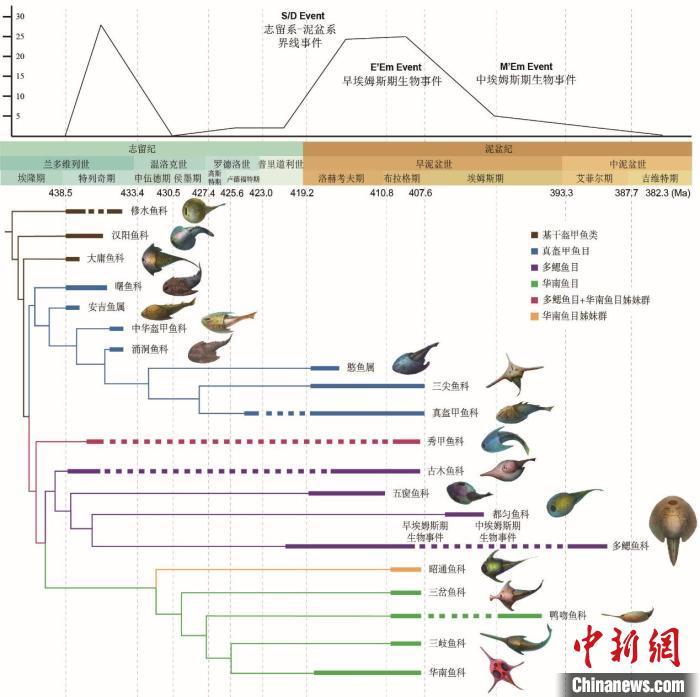
The system development relationship, grade diversity, and response diagram of the biological time of muddy basin. Photo of the ancient vertebrae of the Chinese Academy of Sciences
The papers of important achievements in the research on the evolution of ancient fish have been published in the professional academic journal "Ancient vertebrate zoom".
390 million years ago, armor fossils first appeared "Hometown of Dinosaurs"
Meng Xinyuan, the first author of the paper, graduated from the Graduate School of the Chinese Academy of Sciences, graduated from the Graduate Student of the Institute of Ancient Spine, said that the fossil specimen of this study was known as the "Hometown of Dinosaurs" in Yunnan Chuxiong and Yi Autonomous Prefecture. "For the first time, I found 390 million years ago armor fossil.

Oriental fish ecological restoration map (Yang Dinghua). Photo of the ancient vertebrae of the Chinese Academy of Sciences
In the 1930s, the "China First Dragon" discovered and named by Academician Yang Zhongjian, a well -known ancient creature in China -Xu's Lufeng Dragon Fossil was discovered in Lufeng County, Chuxiong Prefecture. The first dinosaur is the treasure of the ancient Chinese zoom hall.
The 390 million years ago, the helmet turtle oriental fish fossil specimen was a part of an incomplete but obvious part of the gill fish head armor. On yellow quartz sandstone. Wuding local muddy discipline (about 400 million years ago) has a more developed stratum, mostly land phases and coastal deposition, and rich fish fossils, including shield -leather fish Wing's martial arts fish, giant picking fish, long pillow pillow, long pillow pillow, long pillow Old town fish, Da Yin's fish, Wu's perfume fish, Chinese Liwo fish and shield leather fish codon scales, Tian's Hunan fish, Qujing west rushing fish, Liu's Yunnan fish, and total fin fish martial arts Fish and so on. Although Wu Ding had discovered the Wuding South China fish fossils of the Tuoda Terriarch (about 410 million years ago), the discovery of armor fossils in Zhongnu Pen (about 390 million years ago) was the first time.
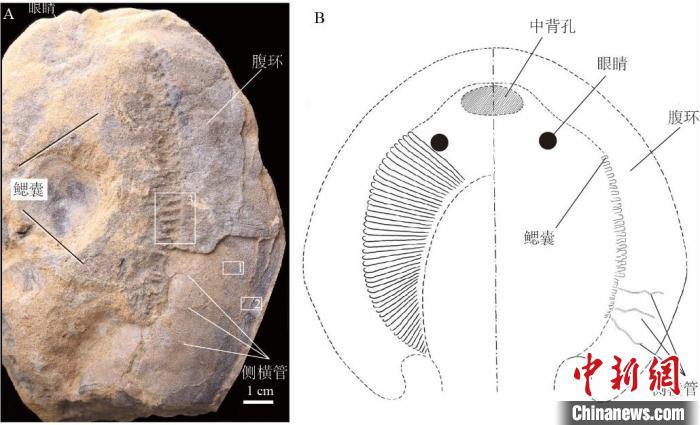
Oriental fish fossil photos (Photo by Gai Zhi) and sketching the original picture (Guo Xiaocong). Photo of the ancient vertebrae of the Chinese Academy of Sciences
Meng Xinyuan said that this Oriental fish fossil is still the second piece of mud pelvic armor fossil specimens found in China after Guangxi. Because armor fossils are mainly produced in China, it is also the second in the world. World helmet turtle fossil specimens.
The most gill sac or a secret weapon in history in history
Researcher Gai Zhiyu, author of the thesis communication, pointed out that gills are the most important respiratory organs of fish and an important place for oxygen exchange. Among the armor of armor, the number of gill sacs is very different in different groups. One of the basis.
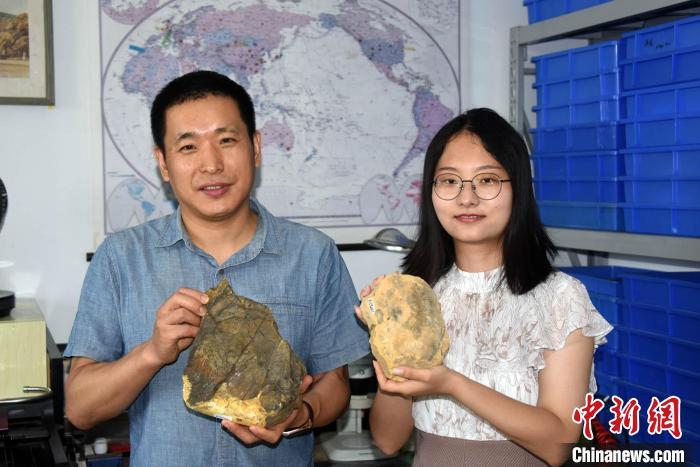
Researcher Gai Zhiyu (left) and the first author of thesis Meng Xinyuan showed the introduction of the two Oriental fish fossil specimens for research. Photo by China News Agency reporter Sun Zifa
The polysmish fish fossils studied this time represent the most well -known gill sacs in the history of the gill sac. For more than 7 times the fish, the gills of existing fish are generally only 5 to 7 pairs.
He said that China was in low latitudes during the early mud basin, and most of them were near the equator, and the environment was very suitable for the survival of various fish. For armor, a small amount of gill sac is enough to ensure the needs of its life body for oxygen. However, many global sea level lifts, oxygen or poverty -stricken oxygen, and biostatic or replacement events have occurred in the pot.
Armor turtle has always been considered to survive in a shallow sea or coastal environment. The evolution of the number of gill sacs can reflect the response to the oxygen incident of the ocean to a certain extent, which is manifested as the number of gill sacs. When the extinction in biological events, only Oriental fish has the largest number of gill sacs in history and continues to live into the mud pelvic world. This may be where they survive the secrets of the bi extermination caused by hypoxia.
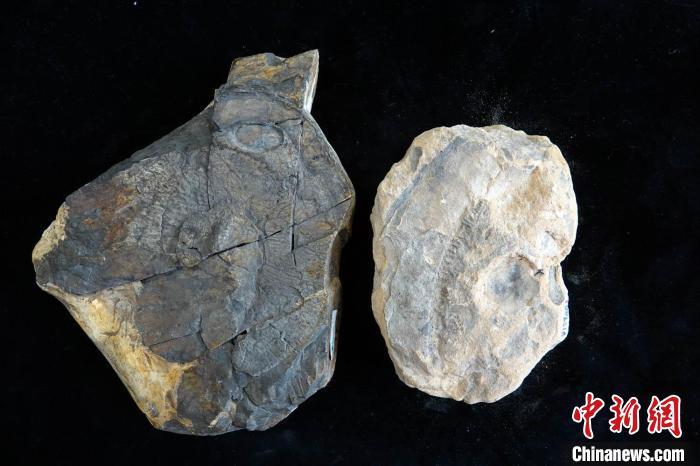
The huge oriental fish fossils (left) and the Oriental fish unregulated fossil specimens in this study. Photo by China News Agency reporter Sun Zifa
Gai Zhiyu said that the number of gill sacs in armor fishes has increased, which has always been an evolutionary phenomenon that is difficult to explain. Research team's new discovery research on Oriental fish fossils shows that it may be the repeated appearance of armor in the early mud pelvis. A evolutionary response of oxygen hypoxia. The study expanded the era of Oriental Fish from about 410 million years ago to about 390 million years ago, and lasted about 20 million years back. This achievement not only fills the geological gaps of gill fish in about 390 million years ago in Yunnan, but also increases the academic community's understanding of the radiation evolution and diffusion and migration routes of the armor of the armor in the mud. The number of sacs and the collaborative evolution of marine hypoxia in about 4.1 years ago is of great significance. Oriental fish fossil "still hug the pipa half -cover" is to be determined
According to Gezhi's science popularization, armfish is a highly diversity and a strong jaw -free category. There are currently 90 species of 66 genus, which are only found in China and northern Vietnam. Except for the drying group (including water -repairing fish, Hanyang fish, and Yongyong fish), the armor of the armor can be divided into three single -type groups -real helper turtle, gill fish eyes and South China fish eyes. Oriental fish belongs to the system classification of the armor of the armor of the armor.
The oriental fish fossils discovered this time only preserved the abdominal ring on the left side of the head armor, but it was already the best turtle specimen to save the best armor. This specimen is compared with half because it is preserved, and the appearance is like the pipa exposed only half of the ancient China. However, although this oriental fish fossil specimen is incomplete, it has the typical characteristics of multi -gill fish, that is, it has more gill sacs (at least 37 pairs of gill sac) in the gill area, which is calculated according to the length of the abdominal ring and the width of each gill sac. It should have up to 45 pairs of gill sacs like huge oriental fish.
390 million years ago in this study, Oriental Fish did not set fossil specimens. Photo by China News Agency reporter Sun Zifa
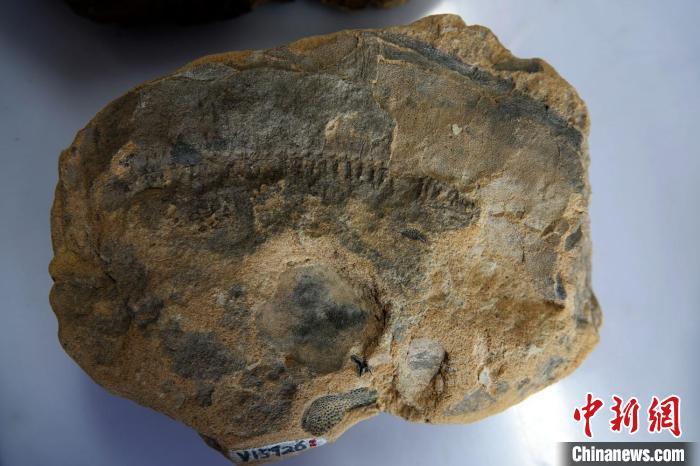
He believes that the storage part of the fossil specimens in this study indicates that its abdominal ring is wide and long, which is a larger gill fish with large individuals. The orbital holes are large and round. The granular protrusions, especially the number of these features, indicate that they should belong to Oriental Fish. As for whether this specimen represents a new species of Oriental Fish, because the specimen does not save key information such as nostrils and orbital holes, the research team has not been named for new species. New fossil materials were found to be determined by further research.
Gai Zhiyu said that as one of the three major categories of armor, the earliest polysitic fossil records can be traced back to about 438 million years ago. Until the early mud pelvis, the gill fishes ushered in radiation evolution. The discovery and research of the fossils showed that Oriental Fish survived after about 400 million years of bi extermination, and survived until the Mud Pen Pole.
He said that in terms of the influence of muddy biological incidents on the diversity of armor species, from Yunnan Wanzhi (approximately 425 million years ago) to the morning-Zhongnu Penjie to Ningxia to Ningxia's late clay pot ( About 382 million years ago), the early-Mid-Mud of the Muds of Mud in Guangxi was found to the east to Guangxi, but the times and regions were different. Mystery also needs further research in the future. (Finish)
Source: China News Network
- END -
Samsung Electronics delays 3 nano -chip production delays
Zhongxin Jingwei, June 22. According to Taiwan's Economic Daily, Samsung Electronics has denied reports on the mass production of the Korean media East Asia Daily on the 22nd. Earlier, the East As...
Alipay open merchant coupon interface: support one -click promotion to public and private domain positions

According to the Alipay opening platform on June 16, in order to meet the marketin...